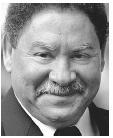SÃO TOMÉ AND PRÍNCIPE
Fradique Melo Bandeira de Menezes
President

(pronounced "fra-DEEK MAY-low bahn-DARE-ah duh mehn-EEZ-ess")
"If you think I'm going to be merely a ceremonial figure, you are mistaken."
The Democratic Republic of São Tomé and Príncipe consists of two islands, São Tomé and Príncipe, located off Africa's west coast. Combined, the two islands comprise 964 sq km (372 sq mi), making it second only to the Seychelles Islands as Africa's smallest nation. Its nearest neighbors to the east are Cameroon, Gabon, and Equatorial Guinea. The islands form part of a chain of extinct volcanoes and are both quite mountainous. The climate is tropical, but temperatures vary a good deal with altitude. Coastal temperatures average around 27ºC (81ºF), but the mountain regions average only 20ºC (68ºF). Seasons are distinguished more by a change in precipitation than by a change in temperature. The rainy season extends from October to May, and average annual rainfall varies from 50–100 cm (20 to 39 in), most of it falling on the southern portions. The capital is the town of São Tomé, located on the northeast coast of the island of São Tomé.
Reflecting its colonial history and economic links to Portugal, over 90% of its population is Roman Catholic and the primary language is Portuguese. Many of its native-born people, called the forros , speak a Portuguese-based Creole language while recent migrants from Mozambique and Angola, the angolares , speak Portuguese. In recent years, laborers from Mozambique and Angola have arrived in large numbers and have increased the country's estimated population to over 170,372 (2002). Approximately 80% of the population resides on São Tomé with the remainder on Príncipe. A pattern of migration and colonialism forms the background to the modern politics and economy of this archipelago nation.
São Tomé and Príncipe's economy is based on the export of agricultural crops, such as cocoa, coconut, palm kernels, and bananas to Western Europe, especially Portugal. Together with fishing, agriculture accounted for 21% of GDP and more than 95% of exports in 2001. The currency unit is the dobra . The GDP is US$189 million, growing at an annual average rate of 5.0% (2002). Per capita GDP is estimated at US$1,200 (2001). Inflation was reduced from a 1997 high of 68.2% to 9.0% in 2002 and the local currency has stabilized. São Tomé and Príncipe was ranked 118th out of 173 countries on the UN human development index (HDI), the fifth highest ranking among sub-Saharan Africa countries, but there are doubts about the accuracy of this measurement.
Presently, the national economy is dependent on loans and development aid from the World Bank (WB) and other donors. The structure of the economy, however, will soon be transformed owing to major off-shore oil and gas deposits expected to come on stream in 2005–06.
Comment about this article, ask questions, or add new information about this topic: